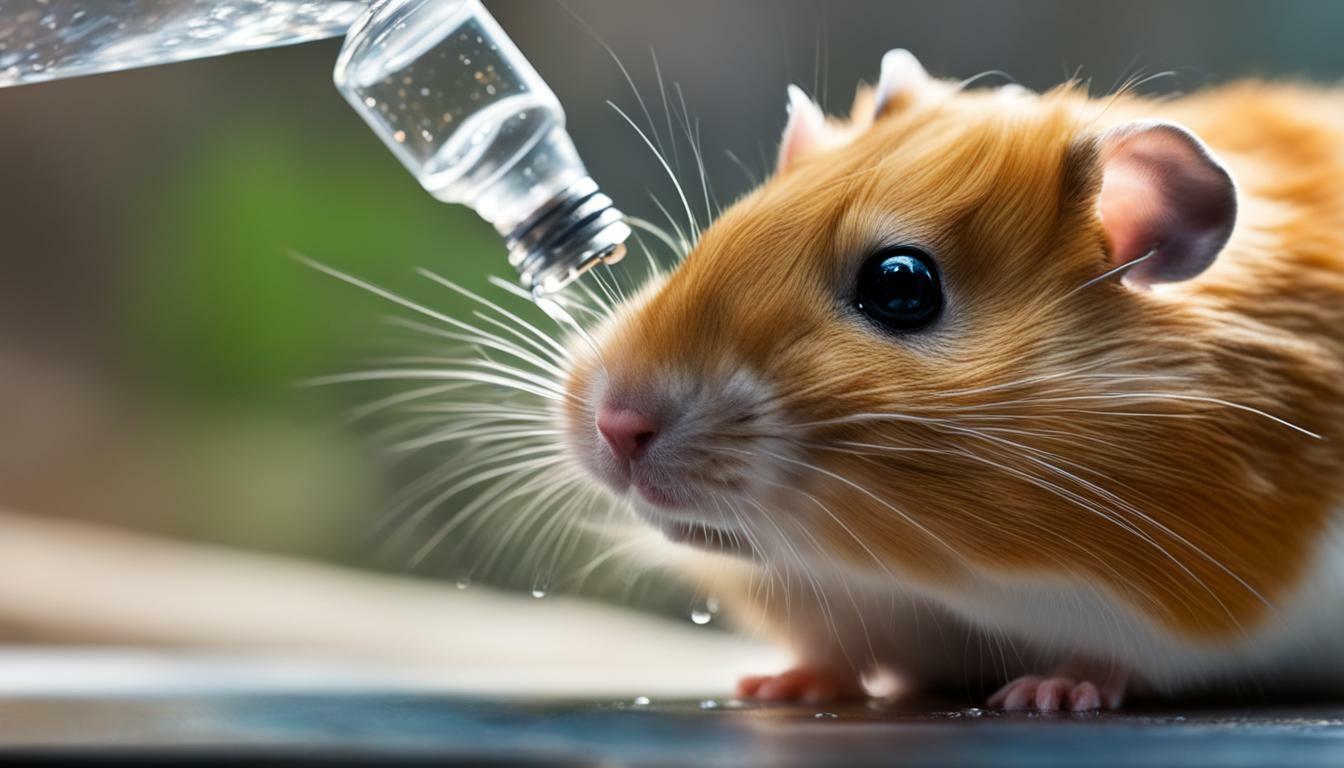Hamsters are small animals that require water to survive, but have you ever wondered how long they can go without it? Dehydration can be fatal for these furry companions and can lead to various health issues. It is crucial to understand their water needs and provide them with adequate hydration.
Key Takeaways:
- Hamsters can typically survive a couple of days without water, but it is not advisable to let them go without it for too long.
- The amount of time a hamster can live without water depends on factors such as their health, age, environment, and temperature.
- It is important to monitor their water consumption and provide multiple water bottles in their cage to ensure easy access.
- If you are planning to go on vacation, arrange for someone to check on your hamster or consider taking them to a boarding facility where their water needs can be met.
- Leaving a hamster alone for too long without water can result in regressive behavior and aggression.
By understanding the importance of water for hamsters and taking necessary precautions, you can ensure their well-being and longevity.
Factors Affecting Hamsters’ Water Needs
Several factors play a role in determining how long hamsters can survive without water. Their overall health is a crucial factor to consider. A healthy hamster has a better chance of withstanding water deprivation compared to one with pre-existing health issues. Age also plays a role, as younger hamsters may be more susceptible to dehydration than adults. Additionally, the environment and temperature can greatly impact a hamster’s water needs.
Hamsters living in hot or dry environments tend to require more water to stay hydrated. High temperatures can cause increased water loss through evaporation, making it essential to provide ample water sources. It is important to note that hamsters are not naturally adapted to arid conditions, so it is crucial to monitor their water intake carefully.
To ensure your hamster’s well-being, it is recommended to create a comfortable and hygienic living environment. A clean and suitable cage, complete with multiple water bottles, will make it easier for your hamster to access water. Providing fresh and clean water daily is vital to prevent contamination and dehydration.
If you plan to be away for an extended period or go on vacation, it is crucial to make arrangements for someone to check on your hamster. Alternatively, you can consider taking them to a reputable boarding facility where their needs can be properly attended to. Leaving them alone for too long can result in regressive behavior and aggression, which can be stressful for both you and your pet.
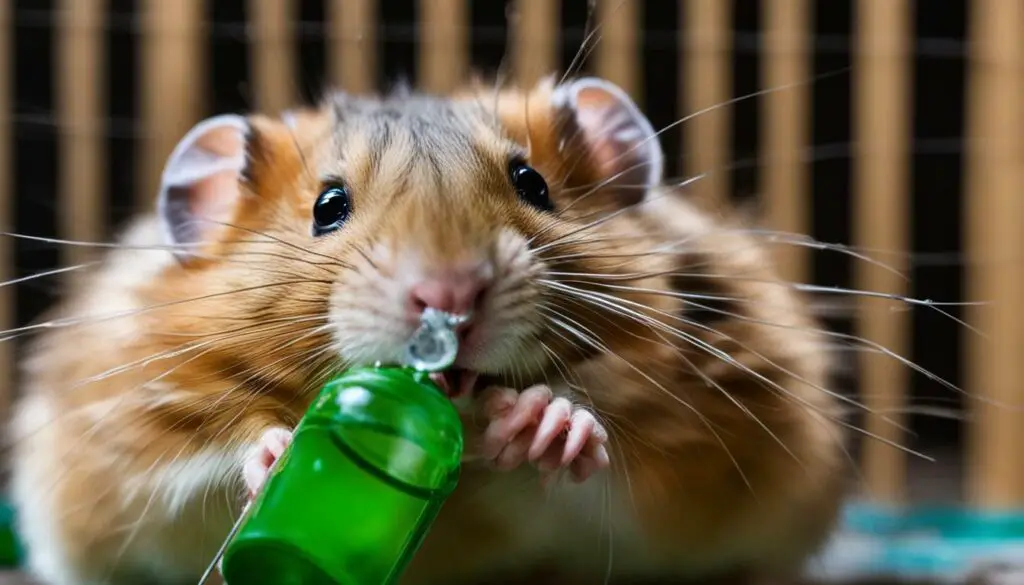
| Factors | Impact on Water Needs |
|---|---|
| Health | Hamsters with pre-existing health issues may have higher water needs. |
| Age | Younger hamsters may require more water than adults. |
| Environment | Hot or dry environments can increase water loss through evaporation. |
| Temperature | Higher temperatures can lead to increased water needs for hamsters. |
Typical Water Consumption for Hamsters
On average, hamsters require a certain amount of water each day to stay hydrated and maintain their overall health. The exact amount of water needed can vary depending on factors such as the hamster’s size, activity level, and the temperature of their environment. It is important to ensure that your hamster has access to clean, fresh water at all times.
The typical water consumption for hamsters ranges from 10 to 20 milliliters per 100 grams of body weight per day. For example, a hamster weighing 150 grams would require approximately 15 to 30 milliliters of water daily. This can be provided through water bottles specially designed for hamsters, which can be attached to the side of their cage.
It is important to monitor your hamster’s water consumption to ensure they are getting enough. If you notice a significant decrease in their water intake or any signs of dehydration, such as a dry nose or sunken eyes, it is essential to take action immediately. Dehydration can lead to serious health issues and can be fatal for hamsters.
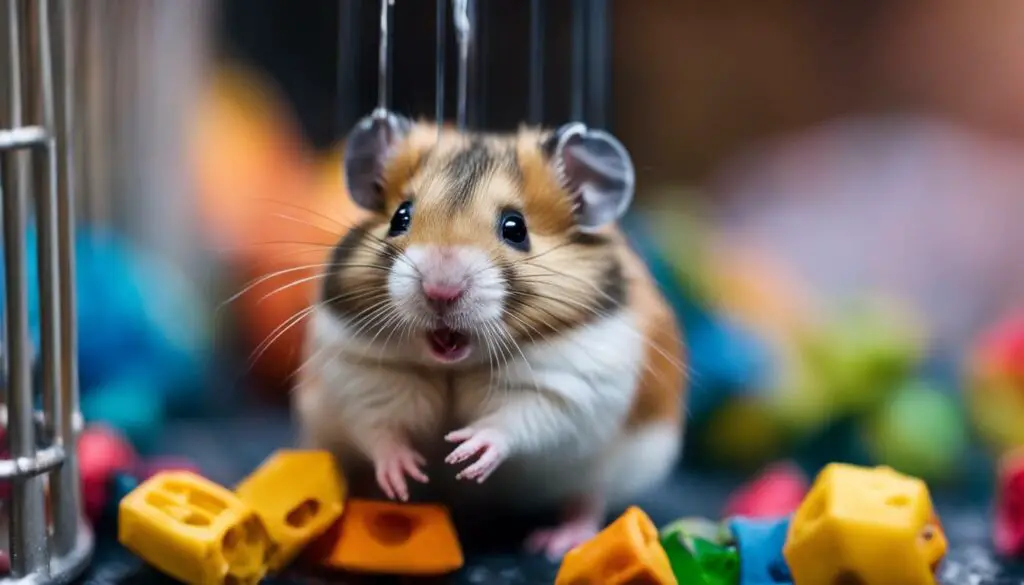
- Provide multiple water bottles in your hamster’s cage to ensure easy access to water.
- Regularly check the water bottles to ensure they are clean and functioning properly.
- Use fresh, filtered water or water that has been allowed to sit for 24 hours to remove any chlorine before giving it to your hamster.
- Consider using a water dispenser or bowl in addition to water bottles, as some hamsters may prefer to drink from a different source.
By monitoring and ensuring adequate water consumption for your hamster, you can help keep them hydrated and promote their overall well-being. Remember to always consult with a veterinarian for any specific advice regarding your hamster’s water needs.
| Hamster’s Weight (grams) | Water Consumption (milliliters) |
|---|---|
| 50 | 5-10 |
| 100 | 10-20 |
| 150 | 15-30 |
| 200 | 20-40 |
Risks of Water Scarcity for Hamsters
Water scarcity can pose significant risks to the health and lifespan of hamsters. While these small furry creatures are known to be resilient, prolonged dehydration can lead to severe consequences. Hamsters typically have a higher water requirement than other pets due to their small size and fast metabolism, making access to clean and fresh water crucial for their well-being.
Depriving hamsters of water can result in dehydration, which can lead to a range of health issues. Their bodies rely on water to regulate body temperature, aid digestion, eliminate waste, and maintain overall physiological functions. Without sufficient water intake, hamsters may experience dry mouth, lethargy, weight loss, and even organ failure. The lack of water can also impact their fur quality, making it dull and brittle.
“Depriving hamsters of water can result in dehydration, which can lead to a range of health issues.”
In addition to physical ailments, water scarcity can also have a negative effect on a hamster’s behavior. Dehydrated hamsters may exhibit regressive behavior, becoming more irritable, aggressive, or withdrawn. This shift in behavior is a result of their heightened stress levels and discomfort due to the lack of hydration. It is essential to provide ample water sources and encourage regular drinking habits to maintain a happy and healthy hamster.
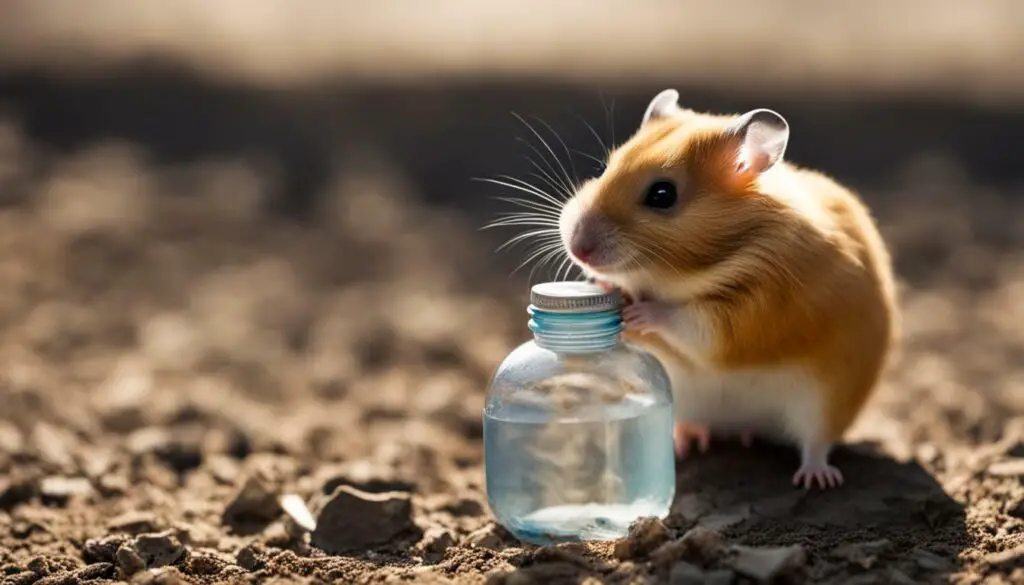
To prevent the risks associated with water scarcity, it is important to monitor your hamster’s water consumption closely. Ensure that their water bottle is filled with clean, fresh water daily, and check for any signs of leakage or blockages. It is also advisable to provide multiple water bottles in their cage to ensure easy access to water. Additionally, maintaining a suitable temperature and humidity level in their environment can help minimize the risk of dehydration.
| Signs of Dehydration in Hamsters |
|---|
| • Dry mouth and nose |
| • Lethargy or weakness |
| • Weight loss |
| • Reduced urine production |
| • Sunken eyes |
Remember, proper hydration is crucial for your hamster’s overall health and lifespan. Be vigilant in monitoring their water consumption and providing a steady supply of water to prevent dehydration-related health issues. By prioritizing their hydration needs, you can ensure that your beloved furry friend remains happy and flourishing.
Monitoring Hamsters’ Water Consumption
It is important to monitor your hamster’s water consumption to prevent dehydration and associated health problems. Hamsters can typically survive a couple of days without water, but prolonged water deprivation can be fatal for them. Dehydration in hamsters can lead to various health issues, including organ failure and a weakened immune system.
Factors such as their health, age, environment, and temperature can influence how long a hamster can go without water. It is crucial to pay attention to your hamster’s behavior and physical condition to ensure they are adequately hydrated. Common signs of dehydration in hamsters include dry mouth, lethargy, sunken eyes, and loss of appetite. If you notice any of these symptoms, it is vital to act promptly by offering them water and contacting a veterinarian if necessary.
To monitor your hamster’s water consumption, you should provide multiple water bottles in their cage. This ensures easy access to water and reduces the risk of water scarcity. It is recommended to check the water bottles daily to ensure they are clean and functioning correctly. If you have multiple hamsters in the same cage, make sure each hamster has their own water bottle to prevent aggression and competition for resources.
Table: Signs of Dehydration in Hamsters
| Signs of Dehydration | Description |
|---|---|
| Dry mouth | Excessive thirst, sticky saliva, or lack of saliva production |
| Lethargy | Unusually low energy levels, lack of interest in activities |
| Sunken eyes | Eyes appear sunken or dull |
| Loss of appetite | Reduced or complete lack of interest in food |
If you are planning to go on vacation or will be away from home for an extended period, it is important to make arrangements for your hamster’s water needs. Leaving them alone without proper care can result in dehydration and regressive behavior. Consider having someone you trust check on your hamster’s water supply and overall well-being while you are away. Alternatively, you can also opt to board your hamster at a reliable facility that provides proper care and attention.
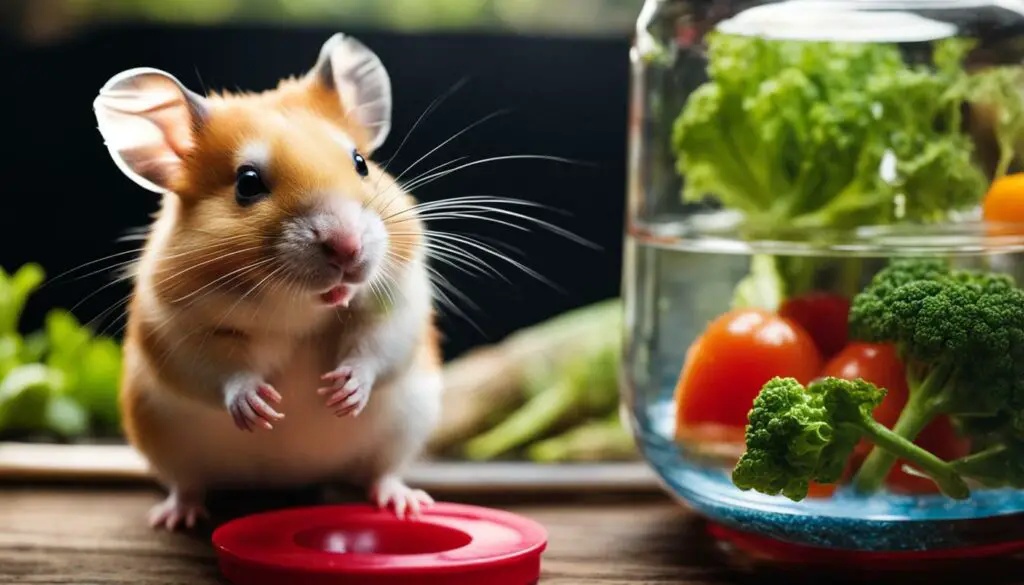
Remember, maintaining proper hydration is essential for the overall health and well-being of your hamster. By monitoring their water consumption and taking necessary precautions, you can help prevent dehydration and ensure your furry friend remains happy and healthy.
Providing Water in the Hamster’s Cage
To meet their water needs, it is recommended to provide multiple water bottles within your hamster’s cage. Hamsters require a constant supply of fresh water to stay hydrated and maintain their overall health. Having multiple water bottles ensures that your hamster always has access to water, even if one bottle runs out or becomes contaminated.
When choosing water bottles for your hamster, opt for ones specifically designed for small animals. These bottles typically have a small, drip-proof nozzle that allows your hamster to easily access the water without spilling or wasting it. Place the bottles in different areas of the cage to encourage your hamster to explore and drink from different locations.
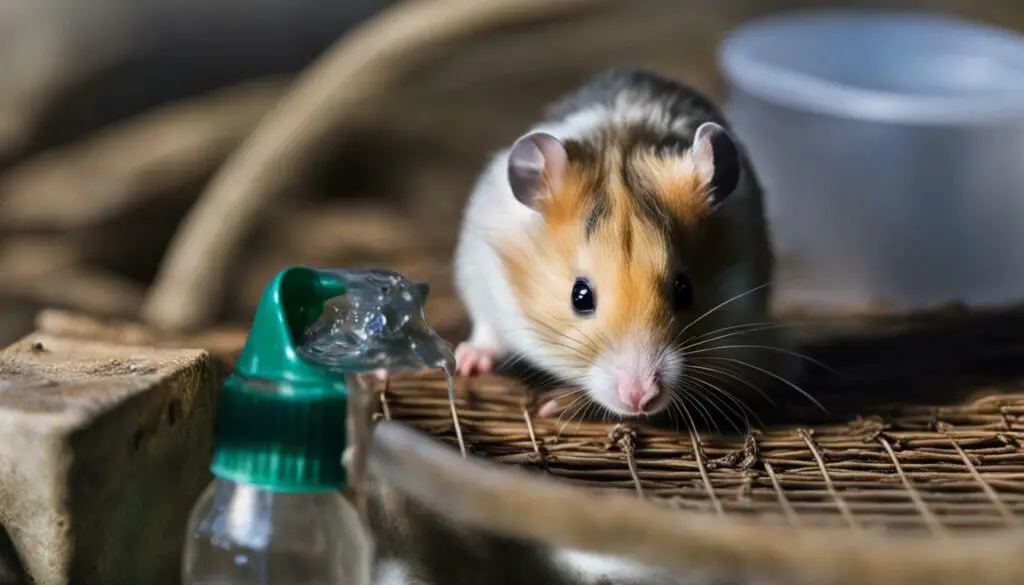
Monitor the water bottles regularly to ensure they are working properly and free from any blockages or leaks. Clean and refill the bottles with fresh water on a daily basis to maintain cleanliness and prevent the growth of bacteria. Additionally, it is advisable to replace the water bottles every few months to avoid any buildup of residue or mold.
Remember that the water needs of your hamster may vary depending on factors such as temperature, diet, and activity level. During warmer months or if you have a particularly active hamster, you may need to provide additional water sources, such as a small shallow dish, to prevent dehydration.
In summary, providing multiple water bottles in your hamster’s cage is crucial for meeting their water needs. Regularly monitor and clean the bottles to ensure a constant supply of fresh water for your furry friend. By taking these simple steps, you can help ensure your hamster stays hydrated and healthy.
Ensuring Water Availability during Vacation or Absence
If you are going on vacation or will be away for an extended period, it is crucial to ensure your hamster has access to water. Hamsters can become dehydrated quickly, leading to various health issues and even a shortened lifespan. Leaving them without water for too long can be fatal, so it’s essential to take the necessary precautions.
One option is to have someone check on your hamster regularly while you’re away. This person can refill the water bottles and ensure that your furry friend has enough water throughout your absence. It’s important to give clear instructions on how much water needs to be provided and how often the bottles should be refilled.
Another option is to consider boarding your hamster at a reputable facility that specializes in small animal care. These facilities have experienced staff who can provide proper care and ensure that your hamster’s water needs are met. This option gives you peace of mind knowing that your beloved pet is in good hands.
If neither of these options is feasible, you can try using a water dispenser that provides a continuous supply of water. These dispensers can be attached to the cage and allow your hamster to access water whenever they need it. However, it’s important to ensure that the dispenser is securely attached and doesn’t leak, as this can create a mess and potentially harm your hamster.
Remember, water is vital for your hamster’s health and well-being. By taking the necessary steps to ensure their water availability, you can help prevent dehydration and keep your furry friend happy and hydrated.
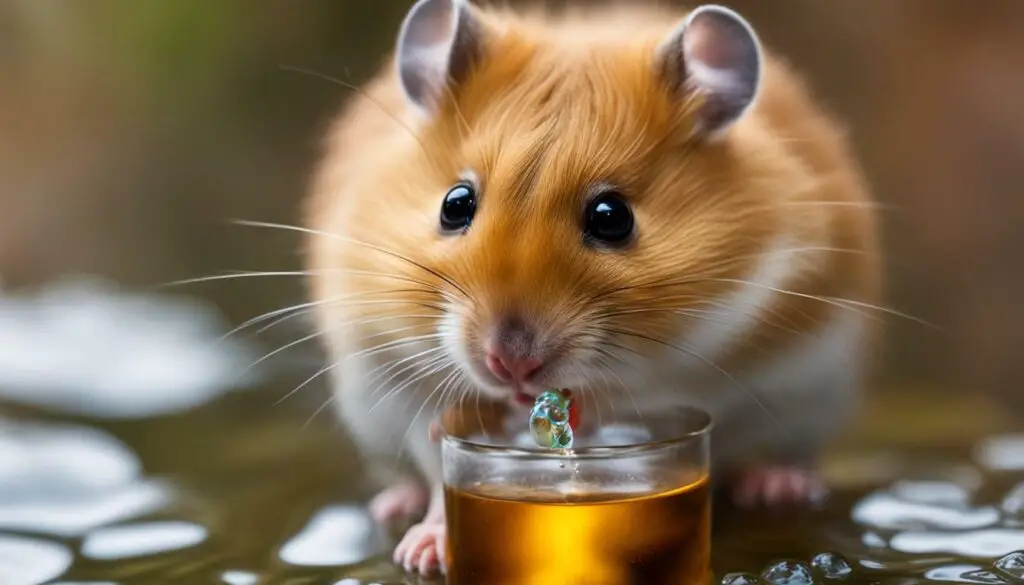
When choosing a water dispenser for your hamster, it’s crucial to select one that is suitable for their size and needs. Here are a few options:
| Dispenser Type | Description |
|---|---|
| Drip Bottle | A traditional water bottle that releases water in small drips when the hamster licks the metal tube. Ensure the bottle is securely attached and doesn’t leak. |
| Gravity-Fed Bottle | A bottle that uses gravity to dispense water into a dish or trough. These are suitable for larger cages or multiple hamsters. |
| Water Bowl | A shallow dish filled with water. This option may be messier, as hamsters may kick bedding into the bowl, but it provides easy access to water. |
Whichever option you choose, it’s important to regularly clean and refill the dispenser to ensure your hamster has access to fresh, clean water. Monitoring the water level and cleanliness daily is crucial to keep your hamster healthy and hydrated.
Behavioral Changes and Aggression due to Water Deprivation
Water deprivation in hamsters can lead to regressive behavior and increased aggression. When hamsters do not have access to enough water, they can become stressed, anxious, and irritable. This can result in changes in their behavior, such as decreased activity levels, loss of appetite, and even aggression towards humans or other hamsters. It’s important to remember that water is essential for their overall well-being and proper hydration is crucial for their physical and mental health.
Dehydration can cause hamsters to feel uncomfortable, restless, and on edge. They may become more territorial and defensive, displaying aggression towards their cage mates or even their owners. It is not uncommon for dehydrated hamsters to exhibit biting or scratching behaviors as a way to protect themselves or establish dominance. These behavioral changes are a clear indicator that something is wrong and immediate action should be taken to provide them with adequate water.
To prevent dehydration and its associated behavioral issues, it is crucial to monitor your hamster’s water consumption regularly. Ensure that they have access to clean, fresh water at all times by providing multiple water bottles in their cage. This will make it easier for them to find water and encourage them to drink more. Additionally, it is recommended to check the water bottles daily to ensure they are functioning properly and not clogged.
Signs of Dehydration in Hamsters:
- Loss of appetite
- Dry, sticky gums
- Decreased activity levels
- Sunken or dull eyes
- Weight loss
- Lethargy
If you notice any of these signs, it is important to take immediate action. Offer your hamster a shallow dish of water or wet their food to provide them with some temporary hydration. However, it is crucial to consult a veterinarian for proper guidance and treatment to ensure their well-being.
| Water Bottle Tips | Benefits |
|---|---|
| Use glass or high-quality plastic water bottles | Prevents contamination and leaks |
| Position the water bottle at a comfortable height | Easier access for the hamster |
| Secure the water bottle to the cage | Prevents tipping and accidental spills |
| Regularly clean and refill the water bottle | Maintains hygiene and freshness |
Remember, preventing dehydration and providing adequate water for your hamster is crucial to their overall health and well-being. By monitoring their water consumption, providing multiple water bottles, and recognizing the signs of dehydration, you can help prevent behavioral changes and aggression caused by water deprivation.
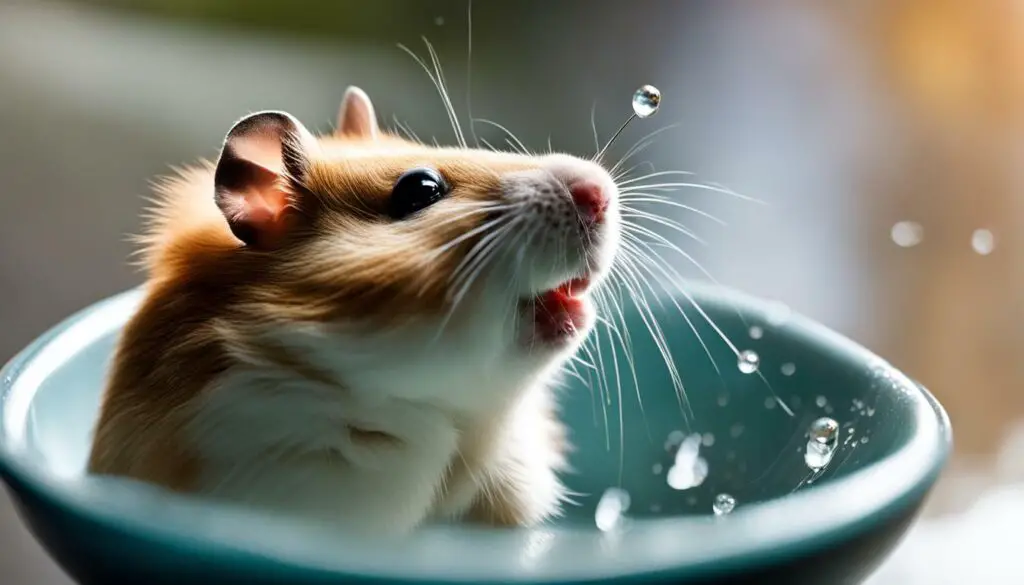
In conclusion, while hamsters can survive for a couple of days without water, it is crucial to prioritize their hydration for their overall health and longevity. Dehydration can be fatal and lead to various health issues. Therefore, it is important to monitor their water consumption and provide multiple water bottles in their cage to ensure easy access.
If you are planning to go on a vacation or will be away for an extended period, it is recommended to have someone check on your hamster or take them to a boarding facility. Leaving them alone for too long can result in regressive behavior and aggression due to water deprivation.
Remember, the amount of time a hamster can survive without water depends on factors such as their health, age, environment, and temperature. By prioritizing their hydration needs, you can prevent potential health issues and ensure their well-being. So, always make sure your furry friend has access to fresh water to keep them happy and healthy.
FAQ
How long can hamsters live without water?
Hamsters can typically survive a couple of days without water, but it is not advised to let them go without water for too long. Dehydration can be fatal and can lead to various health issues.
What factors affect hamsters’ water needs?
Factors such as their health, age, environment, and temperature can influence how long hamsters can live without water.
How much water do hamsters typically consume?
The amount of water a hamster consumes can vary, but it is important to provide them with enough water for their daily needs.
What are the risks of water scarcity for hamsters?
Water scarcity can lead to dehydration, health issues, and a shortened lifespan for hamsters.
How can I monitor my hamster’s water consumption?
It is important to keep an eye on your hamster’s water consumption and ensure they are drinking enough. Watch for signs of dehydration and make adjustments if necessary.
How should I provide water in my hamster’s cage?
It is recommended to provide multiple water bottles in your hamster’s cage to ensure easy access to water at all times.
What should I do about my hamster’s water needs during vacation or absence?
If you are going on vacation or unable to tend to your hamster’s water needs, make arrangements for someone to check on them or consider taking them to a boarding facility where their water needs can be met.
Can water deprivation lead to behavioral changes and aggression in hamsters?
Yes, water deprivation can result in regressive behavior and aggression in hamsters. It is important to provide them with adequate water to prevent these issues.

